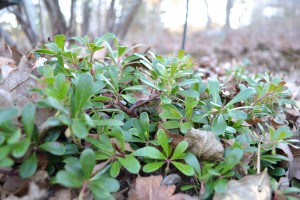 I will have to see whether the common bearberry(Arctostaphylos uva-ursi) will thrive this time around. Last season, I had a couple of these plants tucked away in a no-sun part of the yard, and although they flowered and sprouted new leaves, they quickly died in the fall. I suspect too much moisture (rain run-off and excessive watering on my part) had something to do with it. I planted some more, this time in a partial sun/shade area of the yard, and so far so good – granted it is winter, and time will tell whether they will ever bloom.
I will have to see whether the common bearberry(Arctostaphylos uva-ursi) will thrive this time around. Last season, I had a couple of these plants tucked away in a no-sun part of the yard, and although they flowered and sprouted new leaves, they quickly died in the fall. I suspect too much moisture (rain run-off and excessive watering on my part) had something to do with it. I planted some more, this time in a partial sun/shade area of the yard, and so far so good – granted it is winter, and time will tell whether they will ever bloom.
The common bearberry seems to thrive around the sandy kettle ponds of the Cape, at least in places where there is some sun exposure. I’ve noticed several beds in Nickerson park, and this is where and when I got the idea to introduce the plant in my yard.
Bearberry is a supposedly extremely winter hardy plant, and in essence it is a slow-growing, evergreen ground cover that will typically grow to 6 to 12 inches high and 3 to 6 feet wide. I planted mine a bit closer than that – may the best uva-ursi win. Over time, a bearberry plant can spread (by stem rooting) to cover a very large area of up to 15′ in diameter. This ground cover features reddish-gray, peeling bark and small, lustrous, dark green leaves (although those may turn red or even brown in freezing conditions). Nodding racemes of white, heather-like flowers with a pink tinge appear in April-May – I’ve seen these on the Nickerson plants and they are quite spectacular. Flowers give rise to bright red fruits which last from August through the winter. The fruits are consumed by birds, but are not widely used for human consumption. I managed to find a recipe which I posted below. Why the name? Uva-ursi means bear’s grape in reference to the fact that bears (as well as birds and rodents) feed on the fruits in the wild. But it’s been a while since anyone’s seen a bear on Cape Cod.
Bearberries can be picked when fully red and ripe in the fall, and can be eaten fresh or dried. Though they are a bit bland when eaten raw, the berries make good substitutes in any dish calling for cranberries.
Bearberry Jam
- 2 quarts whole bearberries
- 3 ounces liquid pectin
- Granulated Sugar
- Sterilized hot jelly jars
Wash the berries thoroughly and put in a medium-sized saucepan. Cook on medium heat, stirring constantly until tender – about 5 minutes. Strain in a strainer, then measure by cupfuls and return to the saucepan. Add an equal amount of sugar in cupfuls to the saucepan and mix well. Bring to a boil, stirring constantly, and add pectin. Continue stirring for one minute and remove from heat. Pour mixture into sterilized hot jelly jars and seal. Store in a cool, dark place and use as needed.
Leave a Reply